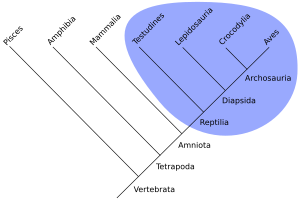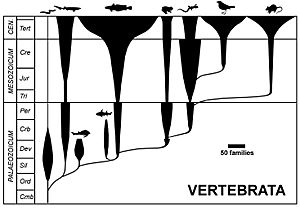Phylogeny facts for kids
A phylogeny is like a giant family tree for all living things on Earth! It shows how different organisms are related to each other through their shared evolutionary history. Scientists believe that all life on Earth is connected because it came from a single ancestor a very, very long time ago.
The main result of studying phylogeny is a phylogenetic tree, also called a tree of life. This is a special diagram that looks like a tree. It shows how different species are connected, just like branches on a tree. It helps us see who is related to whom, and how far back their common ancestors lived. Sometimes, these trees even show when different groups of life appeared during Earth's history.
Contents
What is a Phylogenetic Tree?
A phylogenetic tree is a map of life's history. Imagine a family tree that goes back millions of years! The "trunk" of the tree represents the oldest common ancestor. As you move up the tree, it branches out. Each branch point shows where a new group of organisms evolved from a common ancestor. The tips of the branches are the species we see today.
This tree helps us understand how life has changed over time. For example, it can show that birds are closely related to dinosaurs, or that humans share a common ancestor with chimpanzees. It's a powerful tool for understanding the incredible diversity of life on our planet.
How Do Scientists Build These Trees?
Scientists use different types of clues to figure out how living things are related. They look for similarities and differences between organisms. The more similarities they find, the more closely related the organisms are likely to be.
Looking at Fossils (Paleontology)
One important clue comes from fossils. Fossils are the preserved remains or traces of ancient life, like bones, shells, or footprints. By studying fossils, scientists can see what ancient organisms looked like and how they changed over millions of years. This helps them place extinct species on the tree of life and understand the timeline of evolution.
Comparing Body Parts (Comparative Anatomy)
Scientists also compare the body parts of different animals. This is called comparative anatomy. For example, a human arm, a bat wing, and a whale flipper all look very different on the outside. But if you look at their bones, they have a similar structure. This suggests that humans, bats, and whales all inherited these similar bone structures from a distant common ancestor.
Studying DNA (Sequence Analysis)
One of the most powerful tools for building phylogenetic trees is studying DNA. DNA is like a blueprint that contains all the instructions for building an organism. By comparing the DNA sequences of different species, scientists can find out how similar their genetic information is. The more similar the DNA, the more closely related the organisms are. This method is very precise and has helped scientists confirm many relationships and discover new ones.
Why Are Phylogenetic Trees Important?
Phylogenetic trees are super useful for many reasons. They help us:
- Understand the history of life on Earth.
- See how different species have evolved and adapted over time.
- Classify organisms into groups based on their relationships, which is called biological classification.
- Track the spread of diseases, like how different types of viruses are related.
- Discover new medicines by studying related species that might have similar biological processes.
In short, phylogenetic trees are like detective maps that help us solve the mystery of life's incredible journey and connections.
Images for kids
-
Rooted phylogenetic tree optimized for blind people. The lowest point of the tree is the root, which symbolizes the universal common ancestor to all living beings. The tree branches out into three main groups: Bacteria (left branch, letters a to i), Archea (middle branch, letters j to p) and Eukaryota (right branch, letters q to z). Each letter corresponds to a group of organisms, listed below this description. These letters and the description should be converted to Braille font, and printed using a Braille printer. The figure can be 3D printed by copying the png file and using Cura or other software to generate the Gcode for 3D printing.
-
An unrooted phylogenetic tree for myosin, a superfamily of proteins.
See also
 In Spanish: Árbol filogenético para niños
In Spanish: Árbol filogenético para niños






